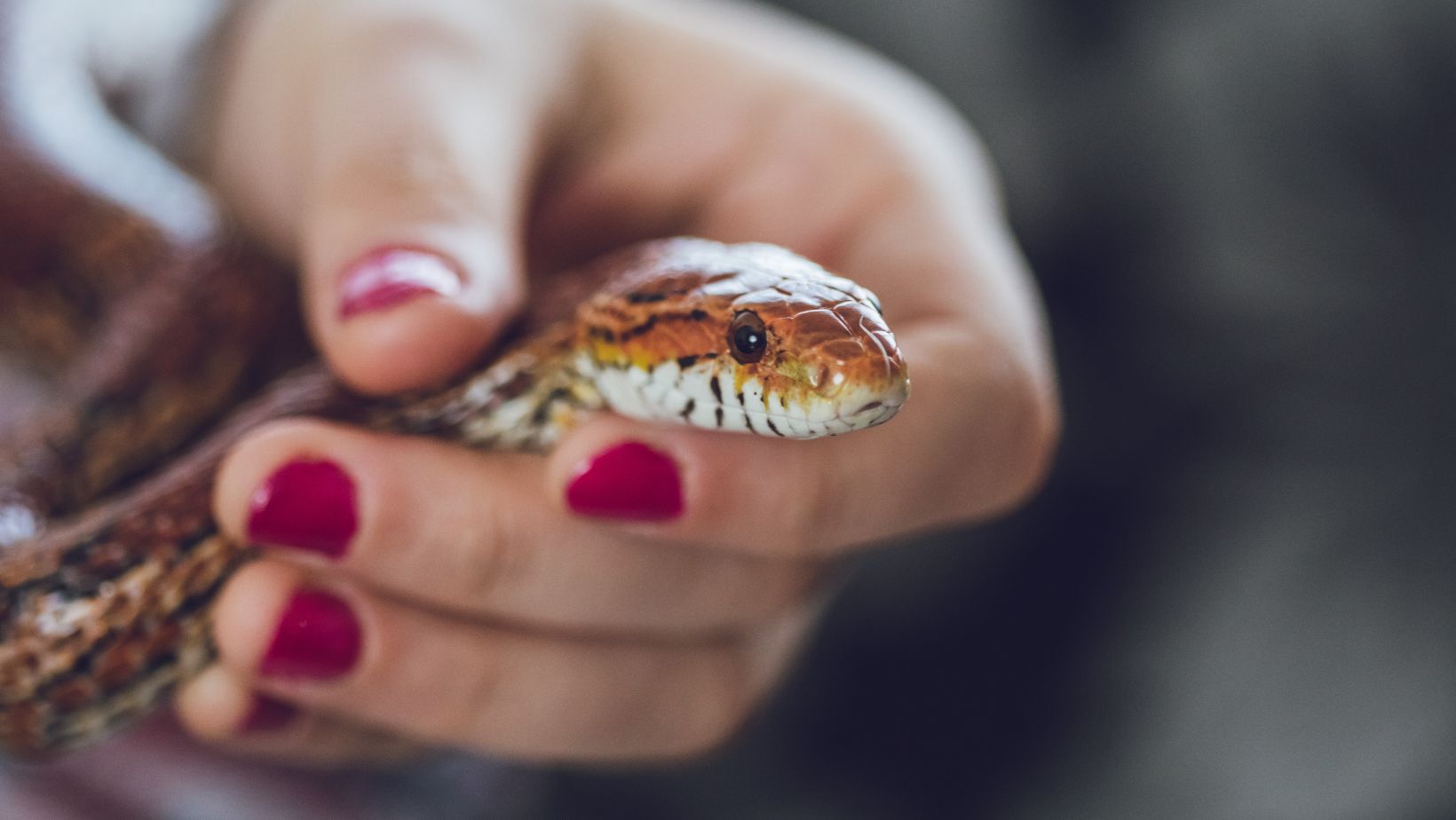
The following is largely translated from “Les Serpents du Laos”, an important work written by J. Deuve and published by ORSTROM (Paris) in 1970. Where more recent information is available, the text has been updated. The original work covers all the snakes of Laos with extensive treatment of the venomous species and other interesting sections such as vernacular names and the distribution of ethnic peoples.
THE SNAKES OF LAOS Sixty-four species of snake have already been recorded in Laos. Another 30 or so species have been recorded near the borders of Laos, and these are likely to be recorded within the country sooner or later. The species of Laos originate from 2 faunas: the Indo-Malaysian fauna of the south (Malaysia, South Burma, Thailand, Cambodia, South Vietnam) and the Palearctic fauna (China, Himalaya, Assam, North Burma, North Vietnam).
Sixty-four species of snake have already been recorded in Laos. Another 30 or so species have been recorded near the borders of Laos, and these are likely to be recorded within the country sooner or later. The species of Laos originate from 2 faunas: the Indo-Malaysian fauna of the south (Malaysia, South Burma, Thailand, Cambodia, South Vietnam) and the Palearctic fauna (China, Himalaya, Assam, North Burma, North Vietnam).
In accordance with the geographic configuration, the numbers of species from respective faunas vary quite markedly. The Annam Highlands are inhabited by species of the Palearctic fauna (e.g. Rhabdophis himalayanus ) at a very low latitude. Whilst, on the other hand, the Mekong valley provides a corridor for species of the Indo-Malaysian fauna to extend further into the north, close to Luang Prabang, or even by the tributaries of the river, up to Xieng Khouang (Gonyosoma oxycephalum, Oligodon herrberti, Drophis mycterizans, Agkistrodon rhodostoma ). In the province of Vientiane, over 30 species have been identified. 17 species have an Indo Malaysian dominance, 5 species a Palearctic dominance and 8 species show a large extension of the range from the north Indo-Malaysian fauna and the south Palearctic fauna. A short distance along the Mekong valley up to a latitude of 19 degrees north (between Vientiane and Luang Prabang) the fauna is Indo Malaysian. In the mountains, the provinces of Namtha, Phong Saly, Sam Neua, clearly have a predominantly Indo Malaysian fauna. The provinces of Xieng Khouang, Vientiane and Thakhek have fauna predominantly one or the other, depending on the locality.
Of the 64 species identified in Laos, 9 species are extremely venomous:
Bungarus fasciatus, and Bungarus candidus, Naja naja and Ophiophagus hannah, Calliophis macciellandi, Calliophi maculiceps, Agkistrodon acutus, Agkistrodon rhodostoma and Trimeresurus gramineus . Seven other sub-species from the sub-family Boiginestet, have venomous fangs situated at the rear of the mouth and are occasionally dangerous; the venom of the others is not virulent (Boiga, Chrysopelea, Dryophis, Psammodynastes ). Finally, 4 species of the sub-family Homalopsines have equally venomous rear fangs but present no danger to a healthy adult.
Up to now the longest snake scientifically measured in Laos is 5.05m (Python), although reports are sometimes received of individuals measuring 7m. Errors are frequently made when measuring the length of a snake skin after skinning. The length of a skin can increase by 20% after tanning. It is difficult to precisely measure the length of the smallest; when they leave the egg the snakes are very small (sometimes centimeters for the Typhlopides ) Laos has a greater proportion of large individual snakes than neighboring countries; especially among Bungarus fasciatus, Agkistrodon rhodostoma and Boiga cyanea . The case is particularly striking in Coelognathus radiatus , with a large number of examples attaining 1.8m, and the proportion of Chrysopelea ornata which attain lengths of over 1 .2m.
Laos is home to a diverse range of snake species, with a total of 64 recorded species. This number is expected to increase as more research is conducted. The snake fauna in Laos is influenced by two main faunal regions: the Indo-Malaysian fauna and the Palearctic fauna. The distribution of snake species in Laos varies depending on the geographic location and habitat types. This article provides an overview of the snakes found in Laos, including information on venomous species, distribution patterns, and vernacular names.
I. Snake Faunas in Laos:
- Indo-Malaysian Fauna: This faunal region includes snakes from countries such as Malaysia, South Burma, Thailand, Cambodia, and South Vietnam. The Mekong valley serves as a corridor for Indo-Malaysian species to extend further north into Laos.
- Palearctic Fauna: This faunal region includes snakes from China, Himalaya, Assam, North Burma, and North Vietnam. The Annam Highlands in Laos are inhabited by species of the Palearctic fauna.
II. Venomous Snakes in Laos:
Out of the 64 snake species identified in Laos, nine species are highly venomous. These include Bungarus fasciatus, Bungarus candidus, Naja naja, Ophiophagus hannah, Calliophis macclellandi, Calliophis maculiceps, Agkistrodon acutus, Agkistrodon rhodostoma, and Trimeresurus gramineus. Several sub-species from the Boiga, Chrysopelea, Dryophis, and Psammodynastes genera also have venomous fangs but are not considered highly dangerous.
III. Snake Species Distribution in Laos:
The distribution of snake species in Laos varies depending on the geographic location and habitat types. The province of Vientiane has recorded over 30 snake species, with a dominance of Indo-Malaysian or Palearctic species depending on the locality. The Mekong valley, especially between Vientiane and Luang Prabang, is dominated by Indo-Malaysian fauna. The provinces of Namtha, Phong Saly, and Sam Neua have a predominantly Indo-Malaysian snake fauna, while Xieng Khouang, Vientiane, and Thakhek have a mix of Indo-Malaysian and Palearctic species.
IV. Snake Species Highlights:
- Oreocryptophis porphyraceus (Elaphe porphyracea): This species is found in the mountains of North Laos, including Xieng Khouang and Sam Neua. There are two sub-species, O. p. porphyraceus and O. p. nigrofasciata, with slight differences in their distribution and coloration patterns.
- Elaphe bella (Elaphe leonardi): Although not yet recorded in Laos, this snake is likely to be found in North Laos.
- Gonyosoma prasinus (Elaphe prasina): Not yet recorded in Laos, this arboreal snake could be found in North Laos.
- Coelognathus radiatus (Elaphe radiata): This snake is commonly encountered near human habitation, including gardens, paddy fields, and roofs of houses. It is known for its climbing ability and predation on rodents and bird eggs.
- Euprepiophis mandarinus (Elaphe mandarina): Found at the northern limits of Laos, this snake is primarily a mountain species.
- Orthriophis taeniurus (Elaphe taeniura): Found in northeastern provinces such as Xieng Khouang, Sam Neua, and Phong Saly, this snake exhibits distinctive coloration patterns.
V. Vernacular Names:
The vernacular names for snakes in Laos vary across different regions and ethnic groups. Common names include Ngou Sa, Ngou Sing, and Ngou Pouak. However, the specific qualifying names can vary widely from village to village.
Conclusion:
Laos is home to a diverse snake fauna, with species originating from both the Indo-Malaysian and Palearctic regions. The country’s geographic configuration and habitat types influence the distribution patterns of snake species. While Laos has recorded nine highly venomous species, it is essential to note that proper caution and expert guidance are necessary when dealing with snakes. Understanding the diversity and characteristics of snake species in Laos contributes to conservation efforts and promotes awareness among the local population.
DEFINITIONS USED
Anterior = half towards the snout
Posterior = half towards the tail
Length = total length from the tip of the snout to the tip of the tail, the body stretched out but not distended.
Relationship of length = (length of tail/length of body) is a factor fairly constant within limits for a given species but provides little aid for identification when, in many species, the relationship is different for the young and the adults. This is referred to as relationship A in the text and is given in millimetres.
The difficulty in establishing exact measurements makes use of the relation ship (number of ventrals/number of sub caudals) preferable. This relationship is much more constant and eliminates a large part of the errors in relationship A. This relationship is referred to in the text as relationship B. In this work the length is generally given in centimeters with the length of the tail in parentheses.
Readers should consult other texts such as Wright and Wright (1976) for diagrams of the head plates and scalation referred to in this text.
GENUS Elaphe
Twelve to twenty-four maxillary teeth subegales – Anterior mandibular teeth longer – Head distinct from neck, elongated – Eye medium with round pupil – Body elongated – 6 species are encountered or likely to be encountered in Laos.
The vernacular names are in general Ngou Sa, sometimes Ngou Sing, followed by another qualifying name which varies widely from village to village.
Oreocryptophis porphyraceus (Elaphe porphyracea) (Cantor)
Rostral noticeably wider than high, visible from above – 2 internasals shorter than prefrontals – frontal wide, roughly equals the distance to the tip of the snout, shorter than the parietals – frenal longer than high – 1 preocular – 2 postoculars. Temporals: 1+2 – supralabials 8 (4.5) – 4 (5) infralabials in contact with the anterior mentonnieres which are longer than the posteriors. Costals smooth, 17-19 – ventrals rounded: 109-218 – anal divided – subcaudals double 48-79 – length 106 cm. Relationship A = 0.14 to 0.19.
Two sub-species are found in Laos, both in mountainous regions.
Oreocryptophis porphyraceus porphyraceus
Top brown, red, pale greyish orochre, with 7 to 13 transverse bars on the back and one to four on the tail. These bars are made up of 2 black transverse lines edged by a thin, light strip at the base. Between these two lines is the ground colour. These bars stop at the ventrals. The width of these bars reaches 4 to 6 scale lengths. Towards the posterior, these bars become irregular and vague. In the posterior part of the body a black longitudinal line on each flank is interrupted by the transverse bars.
Head brown-red or light brown. One thin black line runs down the length of the head in the middle. One thin, black line on each side of the head, going from the eye to the neck. Vent yellowish.
Oreocryptophis porphyraceus nigrofasciata
Coloration and pattern resemble O.p.p. The difference between the two sub-species is the continued presence of the black longitudinal line on both flanks from the neck to the tail.
DISTRIBUTION IN LAOS
Oreocryptophis porphyraceus porphyraceus is found in the mountains of North Laos (Xieng Khouang and Sam Neua). Oreocryptophis porphyraceus nigrofasciata is found between Xieng Khouang and Paksane, in the mountains of the upper Nam Nhiep region
DISTRIBUTION
The area of the species comprises India (Assam, Andamans), South China, Formosa, Hainan, North Burma, Eastern Himalayas, Thailand, Kampuchea, Indo Malaysian Archipelago, Malaysia, mountains of North Vietnam. The sub-species porphyraceu s is found in South China, North Thailand, and North Vietnam. The subspecies nigrofasciata is known from Vietnam, Formosa and South China
Elaphe bella (Elaphe leonardi) (Wall)
Rostral very visible from above – 2 internasals shorter or roughly equal in length to the prefrontals. Frontal base wide, entering fairly deeply into the occipitals. Frenal absent – 1 preocular -2 postoculars. Temporals: 2(1) +2 – supralabials 7 (3.4). 3 or 4 intralabials in contact with the anterior mentonnieres, which are much longer than the posterior. Costals smooth or keeled, 17 to 19 – ventrals rounded, 204-223. Anal divided – sub-caudals double 40-56. Length = 92.7cm – relationship A = 0.14-0.16.
GENERAL APPEARANCE
Head – light brown or brown-red. a light patch in the shape of a ‘V’ of which the arms leave the prefontals and the point reaches the nape of the neck.
Body – Brown or reddish-brown base (red in young specimens), 25 to 30 purplish-red patches, lighter in the middle. Between 5 and 8 of these patches on the tail. The patches are all edged with black. The patches cover the back and sides and stop at the ventrals. Small patches of the same colour between these large patches on the sides. Young specimens have saffron-coloured patches. yellowish, with black patches of varying clarity.
Rostral visible from above, internasal wider than they are long or as wide as they are long. Frontal longer rather than wide, as long as the distance from the tip of the snout, shorter than the parietals. 1 frenal, 1 preocular, 2 postoculars. Temporals 2(1 )+2, supralabials 9 (4.5.6), sometimes 9 (4.5.6) on one side and 10 (5.6.7) on the other. 5 infralabials in contact with the anterior mentonnieres longer than the posterior or roughly the same length.
DISTRIBUTION IN LAOS
Not yet recorded in Laos, this snake is likely to be seen in North Laos.
DISTRIBUTION
North Vietnam, Burma, Assam
Gonyosoma prasinus (Elaphe prasina)
Costals 17-19, smooth or keeled, ventrals laterally keeled 191-208, anal divided. Sub-caudals double 91-111, length 114cm – relationship A = 0.23 to 0.28.
GENERAL APPEARANCE
Bright green, vent green-white or pale yellow.
DISTRIBUTION IN LAOS
Not yet recorded in Laos. Arboreal. Could be seen in North Laos.
DISTRIBUTION
India (Assam, Andamans) – Malay sia – North Vietnam – Vunnan – Burma – Thailand.
Coelognathus radiatus (Elaphe radiata)
 Head distinct from neck, eye small, medium in young. Nostril line enters both nasals. Pupil round – rostral wider than it is high, visible from above. Internasals as wide as they are long but shorter than the pretrontals. Supraoculares as wide as the frontal in the middle. Frontal a little longer than it is wide, longer than the prefontals, shorter than the distance to the tip of the snout (rarely longer), shorter than the parietals, generally with a wide anterior base.
Head distinct from neck, eye small, medium in young. Nostril line enters both nasals. Pupil round – rostral wider than it is high, visible from above. Internasals as wide as they are long but shorter than the pretrontals. Supraoculares as wide as the frontal in the middle. Frontal a little longer than it is wide, longer than the prefontals, shorter than the distance to the tip of the snout (rarely longer), shorter than the parietals, generally with a wide anterior base.
Frenal longer than it is high-i large preocular -2 postoculars – temporals 2+2 in general, sometimes 2+3, occasionally 1+2+2. It often shows dissymmetry (1÷2 and 2+2 or 2+2 and 2+3 or 1+2 and 2=3). Supralabials 8 or 9 (3(4.5) or (4.5) or (4.5.6) or (5.6.7) or dissymmetry) – 9-12 infralabials of which 4 or 5, rarely 6 (oc casionally the number is different on each side) are in contact with the anterior “chin” and are almost as long, or longer, than the posterior chin. These are seperated by the gulares for all or most of their length.
Scales: (17)19(21)-19- 17(15). In the posterior half of the body the scales are generally keeled on the back and smooth on the sides. In the anterior half of the body the scales of the back and flanks are smooth. At the level of the anal scale, the scales of the flanks and back are sometimes entirely keeled, except the outer. The scales of the upper part of the tail are generally smooth or very slightly keeled.
Ventrals: 209-257 with a lateral keel that is obtuse or very obtuse (average in Laos 230-253) – single anal – sub-caudal double 77-108 (average in Laos 86-i 04). Relationship (a) = 0.16 to 0.22 (the tail accounts for 1/4 to 1/6 of the total length of the snake. In the young the relationship sometimes attains 0.26 – maximum length recorded: 200cm, maximum in Laos: 191 .3cm (male from Paksane). Specimens of 1800cm are frequently recorded.
Head brown, ochre or orange – 3 black lines radiate from the eye, black collar on neck, back and flanks brownish changing to grey at the posterior – wide black longitudinal stripes on the flanks. Vent white or yellow changing to grey-blue at the posterior.
Head: all specimens collected in Laos in the Mekong Valley and its tributaries are the same characteristic colour, whatever the season, sex or environment. The essential characteristic is the presence of three black lines radiating from the eye. One line leaves the eye and reaches the infralabials more or less vertically, one line leaves the eye at 45 degrees and joins the supralabials near the corner of the mouth and one line leaves the eye horizontally along the parietals, where it crosses the supratemporals and joins the black collar at the neck, which is broadest at the nape.
In general, 2 fine black longitudinal lines start at the collar (1 on each side of the body) and disappear about 20 scales along the nape. Some specimens have black borders on the anterior of the parietals. The cephalic plate is vivid orange (young individuals) – ginger – reddish-brown – dark brown – dark ochre. The sides of the head are light. The supralabials are clear fawn – yellowish – brown-yellow – dirty yellow. The infralabials are dirty white – pale yellowish – very clear brown. The chin is white or creamy-white, the iris is yellow.
Body: The anterior back and flanks are reddish, light brown, light Sienna or greyish-brown, gradually changing to pale olive-grey, brown-grey, pale blue-grey or even purplish in the posterior part of the body. These colours are often paler at the base of the flanks. The general colouration of the snake often appears as blue or pale blue-grey with black longitudinal stripes. Three black longitudinal stripes on each flank disappearing towards the posterior, sometimes within the first quarter of the body’s length, which are often interrupted or discontinued. Starting from the ventrals there is: the first stripe overlapping the outer borders of the ventrals and the outer costals, the second band occupying 1 or 2 costals (on the third or fourth costal in general) and a third band between 3 and 5 scales wide generally occupying costals 6 to 8 starting from the ventrals. The interstitial skin between the costals is dark grey, greyish or bluish.
Ventrals: The ventrals are white, yellowish or pale olive towards the anterior, becoming more and more stained with a bluish-grey. Posteriorly, the ventrals be come a clear grey-blue, marbled grey or clear slate-grey, the centre much clearer than the outer borders.
Tail: The greater part of the tail is brown, dark brown or brown-grey. The sub-caudals are yellowish, clear brown or brownish-yellow.
DESCRIPTION OF YOUNG Coelognathus radiatus
1 – The general colouration of the head and body is brown-red to brown (posteriorly). The sides of the head are brown-yellow or yellow (supralabials). The underside of the head is whitish-yellow, the ventrals and sub-caudals are yellow anteriorly changing to brown then fiery brown on the tail. The markings on the head are the same as those of the adults (three lines radiating from the eye and a thin black collar).
2 – The markings on one flank comprise:
a – A first black longitudinal line situated near the vertebral column which only appears 3 or 4 head lengths after the neck, irregular, interrupted by white transverse bars. This line becomes progressively thinner, developing a longitudinal white line within it, then disappears.
b – A black longitudinal line made up of elongated patches (at intervals of 4 to 5 and then 5 to 8 scales) more or less bordered by white. In the posterior the black patches become thinner and disappear
c – A longitudinal line of little black elongated patches, bordered by white, which rapidly disappear.
d – As the black lines get thinner and disappear, the white transverse marks (every 5 or 6 scales) become more distinct and remain after the disappearance of the black bands, in the form of more or less regular white transverse bars. They also disappear towards the posterior.
Vernacular Names
Mekong Thai and North Thai: Ngou Sing Sa (Luang – Prabang). Ngou Sa Pouak (north province of Vientiane). Ngou Pouak, Ngou Sing and Ngou Sa (commonly used almost everywhere).
DISTRIBUTION IN LAOS
This snake is encountered on all plains (Mekong and tributaries) and on the high plateau up to an altitude of 1200m (Xieng Khouang and Pak Song). Examples from the Mekong valley show a remarkable consistency as much in their patterning as in the characteristics of their scales.
DISTRIBUTION
East Himalaya – Bengal – Assam – India – South China – Thailand – Burma – Malaysia – Java – Sumatra – Cambodia – South Vietnam and the plains of North Vietnam.
OBSERVATIONS
Coelognathus radiatus is generally encountered near human habitation, including gardens, paddy fields, hen houses and the roofs of houses. This snake lives in barns, in holes at the bottom of trees and in wood piles. It hunts rodents, climbs well and is a big predator of birds’ eggs and chicks. It is equally active day and night. If attacked it is angered easily and strikes. The young have been captured several times, in the town of Vientiane, hiding in the bottom of wardrobes; one of them bit a person rummaging in their wardrobe. It is the species of Ratsnake most commonly encountered on the plains. Young aged 1 to 3 months have only been found during August and September (the ‘rainy season’). At hatching, the young measure 15cm and they can attain a length of 48cm in 2 months. According to Curran and Kauffeld, Coelognathus radiatus may inflate the neck region.
Euprepiophis mandarinus (Elaphe mandarina) (Cantor) Rostral wider than high, visible from above – 2 internasals shorter than the prefontals. Frontal longer than wide or of a length roughly equal to its width, barely shorter than the parietals. Frenal small (sometimes absent or only on one side) 1 preocular – 2(1) postoculars – temporal 1 (2)÷2(3) – supralabials (6) 7(8)(3.4)- 4 infralabials in contact with the anterior mentonnieres, which are longer than the posterior. Costals = (21)23, 23(21), (21)19(17) – ventrals rounded 198-241 – anal divided – subcaudals double 58-84. Length 164cm, relationship A = 0.16 to 0.20.
Rostral wider than high, visible from above – 2 internasals shorter than the prefontals. Frontal longer than wide or of a length roughly equal to its width, barely shorter than the parietals. Frenal small (sometimes absent or only on one side) 1 preocular – 2(1) postoculars – temporal 1 (2)÷2(3) – supralabials (6) 7(8)(3.4)- 4 infralabials in contact with the anterior mentonnieres, which are longer than the posterior. Costals = (21)23, 23(21), (21)19(17) – ventrals rounded 198-241 – anal divided – subcaudals double 58-84. Length 164cm, relationship A = 0.16 to 0.20.
GENERAL APPEARANCE
Back scarlet with black markings and a dorsal series of large, black lozenge-shaped markings with yellow centres. Head brown-red with a black band across the snout, a black band traverses the eyes and a black mark in the shape of a blunted ‘V of which the point is on the posterior part of the frontal with the arms reaching the neck. Vent yellow with black transverse markings.
DISTRIBUTION IN LAOS
This is a snake of the mountains and is encountered at the northern limits of Laos.
DISTRIBUTION
North Vietnam- Burma – Taiwan – Yunnan – Southeast China – Hainan.
Orthriophis taeniurus (Elaphe taenuira) (Cope) Rostral wider than high, visible from above – 2 internasals slightly wider than long or width roughly equal to length. Frontal longer than wide, shorter than the parietals or equal – frenal longer than high – 1 preocular, with a subocular or 2 preoculars – 2 postoculars. Temporals = 2+2 (3) – supralabials 9(8) (5.6, 4.5 or 4.5.6), 5 or 6 infralabials in contact with the anterior mentonnieres, which are longer than the posterior. Costals smooth or keeled 21-27, mostly 23 or 21 – Ventrals angular on the side 225-290 – anal divided – sub-caudals double 84-123. Length 260cm – relationship A = 0.17 to 0.24.
Rostral wider than high, visible from above – 2 internasals slightly wider than long or width roughly equal to length. Frontal longer than wide, shorter than the parietals or equal – frenal longer than high – 1 preocular, with a subocular or 2 preoculars – 2 postoculars. Temporals = 2+2 (3) – supralabials 9(8) (5.6, 4.5 or 4.5.6), 5 or 6 infralabials in contact with the anterior mentonnieres, which are longer than the posterior. Costals smooth or keeled 21-27, mostly 23 or 21 – Ventrals angular on the side 225-290 – anal divided – sub-caudals double 84-123. Length 260cm – relationship A = 0.17 to 0.24.
GENERAL APPEARANCE
Head olive. The black band starts at the frenal, traverses the eye and covers the temporals. Back and flanks ash-grey. In the front third of the body, there are black ‘H’ markings along the back, on the flanks the black markings form elongated ovals. These marks disappear, giving rise to a blackish longitudinal stripe on each flank. The entire tail length is covered by 2 black bands on each side separated by an area of yellow-olive or yellow-grey.
OBSERVATIONS
This snake may give out a sound similar to “meowing”.
DISTRIBUTION IN LAOS
Northeast provinces of Xieng Khouang, Sam Neua, Phong Saly.
DISTRIBUTION
Manchuria – Sikkim – Siberia – Korea – Burma – Yunnan – Southeast China – Haina – Thailand – Malaysia – Indo Malaysian Archipelago – Japanese Archipelago – North Vietnam.

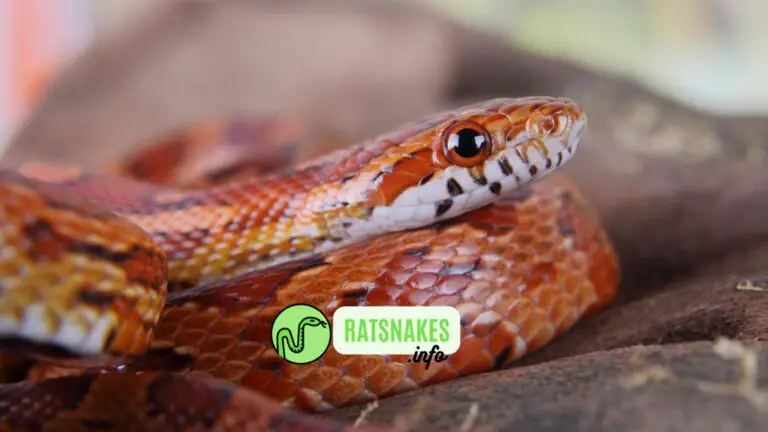
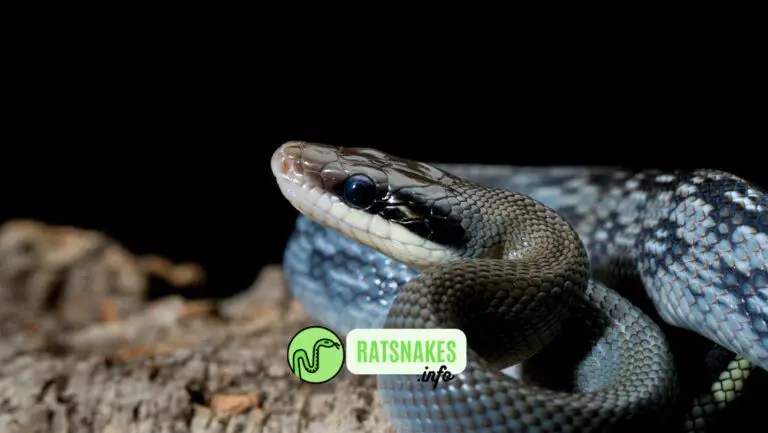
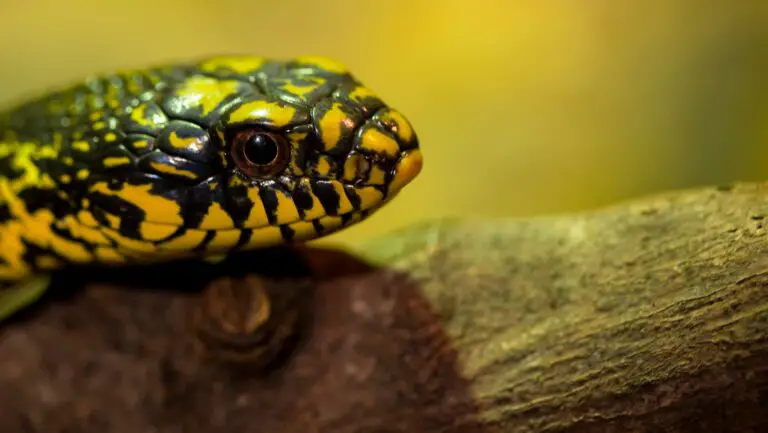
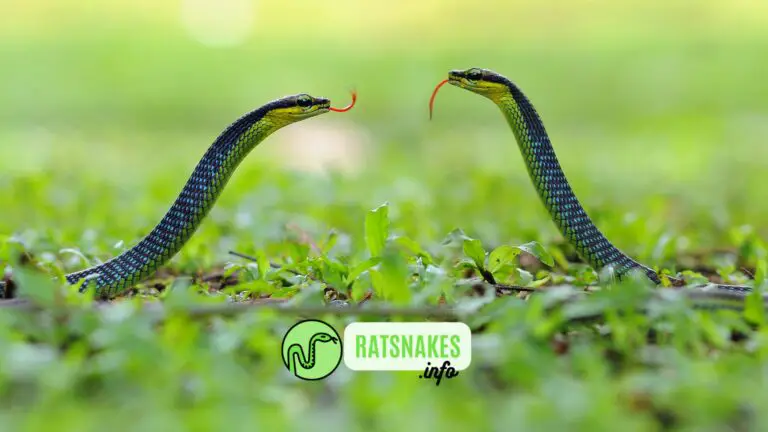
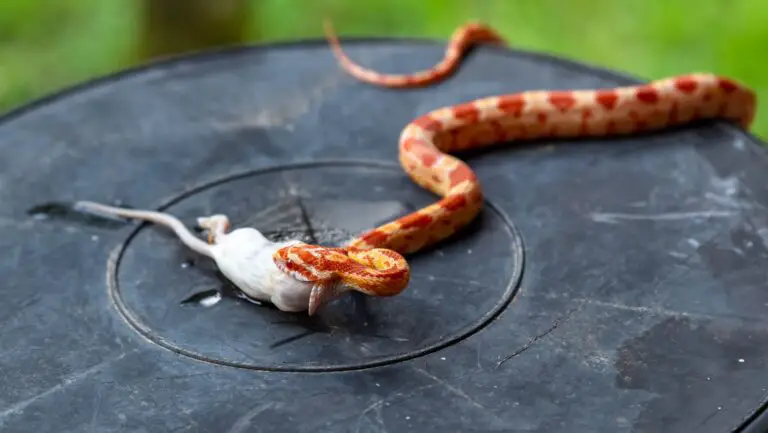
![Prey of Ratsnakes in the Wild [Full List]](https://ratsnakes.info/wp-content/uploads/2022/11/Prey-of-Ratsnakes-768x432.jpg)
